18.5: Hydropower
- Page ID
- 34996
\( \newcommand{\vecs}[1]{\overset { \scriptstyle \rightharpoonup} {\mathbf{#1}} } \)
\( \newcommand{\vecd}[1]{\overset{-\!-\!\rightharpoonup}{\vphantom{a}\smash {#1}}} \)
\( \newcommand{\dsum}{\displaystyle\sum\limits} \)
\( \newcommand{\dint}{\displaystyle\int\limits} \)
\( \newcommand{\dlim}{\displaystyle\lim\limits} \)
\( \newcommand{\id}{\mathrm{id}}\) \( \newcommand{\Span}{\mathrm{span}}\)
( \newcommand{\kernel}{\mathrm{null}\,}\) \( \newcommand{\range}{\mathrm{range}\,}\)
\( \newcommand{\RealPart}{\mathrm{Re}}\) \( \newcommand{\ImaginaryPart}{\mathrm{Im}}\)
\( \newcommand{\Argument}{\mathrm{Arg}}\) \( \newcommand{\norm}[1]{\| #1 \|}\)
\( \newcommand{\inner}[2]{\langle #1, #2 \rangle}\)
\( \newcommand{\Span}{\mathrm{span}}\)
\( \newcommand{\id}{\mathrm{id}}\)
\( \newcommand{\Span}{\mathrm{span}}\)
\( \newcommand{\kernel}{\mathrm{null}\,}\)
\( \newcommand{\range}{\mathrm{range}\,}\)
\( \newcommand{\RealPart}{\mathrm{Re}}\)
\( \newcommand{\ImaginaryPart}{\mathrm{Im}}\)
\( \newcommand{\Argument}{\mathrm{Arg}}\)
\( \newcommand{\norm}[1]{\| #1 \|}\)
\( \newcommand{\inner}[2]{\langle #1, #2 \rangle}\)
\( \newcommand{\Span}{\mathrm{span}}\) \( \newcommand{\AA}{\unicode[.8,0]{x212B}}\)
\( \newcommand{\vectorA}[1]{\vec{#1}} % arrow\)
\( \newcommand{\vectorAt}[1]{\vec{\text{#1}}} % arrow\)
\( \newcommand{\vectorB}[1]{\overset { \scriptstyle \rightharpoonup} {\mathbf{#1}} } \)
\( \newcommand{\vectorC}[1]{\textbf{#1}} \)
\( \newcommand{\vectorD}[1]{\overrightarrow{#1}} \)
\( \newcommand{\vectorDt}[1]{\overrightarrow{\text{#1}}} \)
\( \newcommand{\vectE}[1]{\overset{-\!-\!\rightharpoonup}{\vphantom{a}\smash{\mathbf {#1}}}} \)
\( \newcommand{\vecs}[1]{\overset { \scriptstyle \rightharpoonup} {\mathbf{#1}} } \)
\( \newcommand{\vecd}[1]{\overset{-\!-\!\rightharpoonup}{\vphantom{a}\smash {#1}}} \)
\(\newcommand{\avec}{\mathbf a}\) \(\newcommand{\bvec}{\mathbf b}\) \(\newcommand{\cvec}{\mathbf c}\) \(\newcommand{\dvec}{\mathbf d}\) \(\newcommand{\dtil}{\widetilde{\mathbf d}}\) \(\newcommand{\evec}{\mathbf e}\) \(\newcommand{\fvec}{\mathbf f}\) \(\newcommand{\nvec}{\mathbf n}\) \(\newcommand{\pvec}{\mathbf p}\) \(\newcommand{\qvec}{\mathbf q}\) \(\newcommand{\svec}{\mathbf s}\) \(\newcommand{\tvec}{\mathbf t}\) \(\newcommand{\uvec}{\mathbf u}\) \(\newcommand{\vvec}{\mathbf v}\) \(\newcommand{\wvec}{\mathbf w}\) \(\newcommand{\xvec}{\mathbf x}\) \(\newcommand{\yvec}{\mathbf y}\) \(\newcommand{\zvec}{\mathbf z}\) \(\newcommand{\rvec}{\mathbf r}\) \(\newcommand{\mvec}{\mathbf m}\) \(\newcommand{\zerovec}{\mathbf 0}\) \(\newcommand{\onevec}{\mathbf 1}\) \(\newcommand{\real}{\mathbb R}\) \(\newcommand{\twovec}[2]{\left[\begin{array}{r}#1 \\ #2 \end{array}\right]}\) \(\newcommand{\ctwovec}[2]{\left[\begin{array}{c}#1 \\ #2 \end{array}\right]}\) \(\newcommand{\threevec}[3]{\left[\begin{array}{r}#1 \\ #2 \\ #3 \end{array}\right]}\) \(\newcommand{\cthreevec}[3]{\left[\begin{array}{c}#1 \\ #2 \\ #3 \end{array}\right]}\) \(\newcommand{\fourvec}[4]{\left[\begin{array}{r}#1 \\ #2 \\ #3 \\ #4 \end{array}\right]}\) \(\newcommand{\cfourvec}[4]{\left[\begin{array}{c}#1 \\ #2 \\ #3 \\ #4 \end{array}\right]}\) \(\newcommand{\fivevec}[5]{\left[\begin{array}{r}#1 \\ #2 \\ #3 \\ #4 \\ #5 \\ \end{array}\right]}\) \(\newcommand{\cfivevec}[5]{\left[\begin{array}{c}#1 \\ #2 \\ #3 \\ #4 \\ #5 \\ \end{array}\right]}\) \(\newcommand{\mattwo}[4]{\left[\begin{array}{rr}#1 \amp #2 \\ #3 \amp #4 \\ \end{array}\right]}\) \(\newcommand{\laspan}[1]{\text{Span}\{#1\}}\) \(\newcommand{\bcal}{\cal B}\) \(\newcommand{\ccal}{\cal C}\) \(\newcommand{\scal}{\cal S}\) \(\newcommand{\wcal}{\cal W}\) \(\newcommand{\ecal}{\cal E}\) \(\newcommand{\coords}[2]{\left\{#1\right\}_{#2}}\) \(\newcommand{\gray}[1]{\color{gray}{#1}}\) \(\newcommand{\lgray}[1]{\color{lightgray}{#1}}\) \(\newcommand{\rank}{\operatorname{rank}}\) \(\newcommand{\row}{\text{Row}}\) \(\newcommand{\col}{\text{Col}}\) \(\renewcommand{\row}{\text{Row}}\) \(\newcommand{\nul}{\text{Nul}}\) \(\newcommand{\var}{\text{Var}}\) \(\newcommand{\corr}{\text{corr}}\) \(\newcommand{\len}[1]{\left|#1\right|}\) \(\newcommand{\bbar}{\overline{\bvec}}\) \(\newcommand{\bhat}{\widehat{\bvec}}\) \(\newcommand{\bperp}{\bvec^\perp}\) \(\newcommand{\xhat}{\widehat{\xvec}}\) \(\newcommand{\vhat}{\widehat{\vvec}}\) \(\newcommand{\uhat}{\widehat{\uvec}}\) \(\newcommand{\what}{\widehat{\wvec}}\) \(\newcommand{\Sighat}{\widehat{\Sigma}}\) \(\newcommand{\lt}{<}\) \(\newcommand{\gt}{>}\) \(\newcommand{\amp}{&}\) \(\definecolor{fillinmathshade}{gray}{0.9}\)Hydropower (hydroelectric energy) refers to the energy in moving water, which can be used to generate electricity. It is ultimately driven by solar energy. Water at high elevations is replenished through evaporation (induced by solar heat), condensation, and precipitation. The moving water turns a turbine (figure \(\PageIndex{a}\)) and this moves magnets within a wire coil, causing the movement of electrons in a generator. The result is an electric current (electricity). Combustion of fossil fuels or biofuels, nuclear energy, wind energy, and thermal solar systems all follow this same general mechanism; the difference is what causes the turbine to spin.
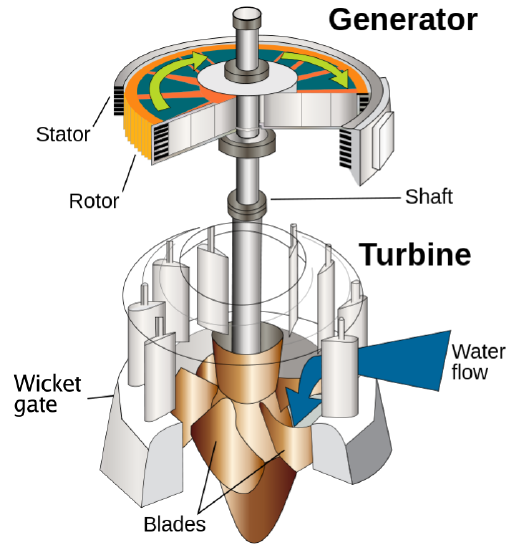
There are several types of hydropower, but each generates electricity through the same general mechanism described above. The most well-known use of hydropower involves dams. Dams block the flow of rivers, producing an artificial lake (reservoir) upstream. The release of water is then controlled. Some of this water moves through a channel (penstock), and this kinetic energy (energy of motion) is harnessed into electricity (figure \(\PageIndex{b}\)). In run-of-the-river hydroelectricity, the turbine is placed directly into a river, and the natural flow of water through the river spins the turbine. Tidal energy and energy from ocean waves (figure \(\PageIndex{c}\)) are also considered forms of hydropower. However, tidal energy arises from the gravitational attraction of the moon and the more distant sun on the earth’s oceans, combined with rotation of the earth. In other words, most forms of hydropower are indirect forms of solar energy, with the exception of tidal energy.
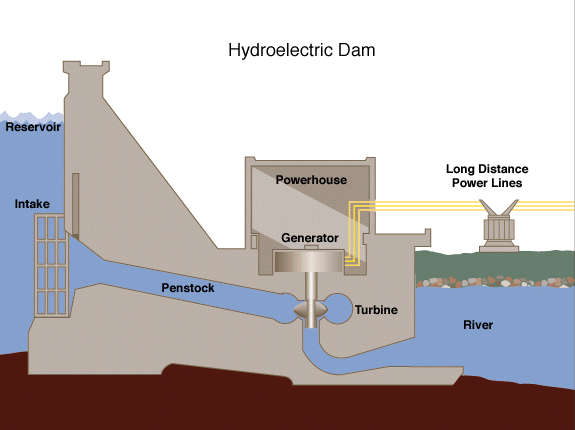
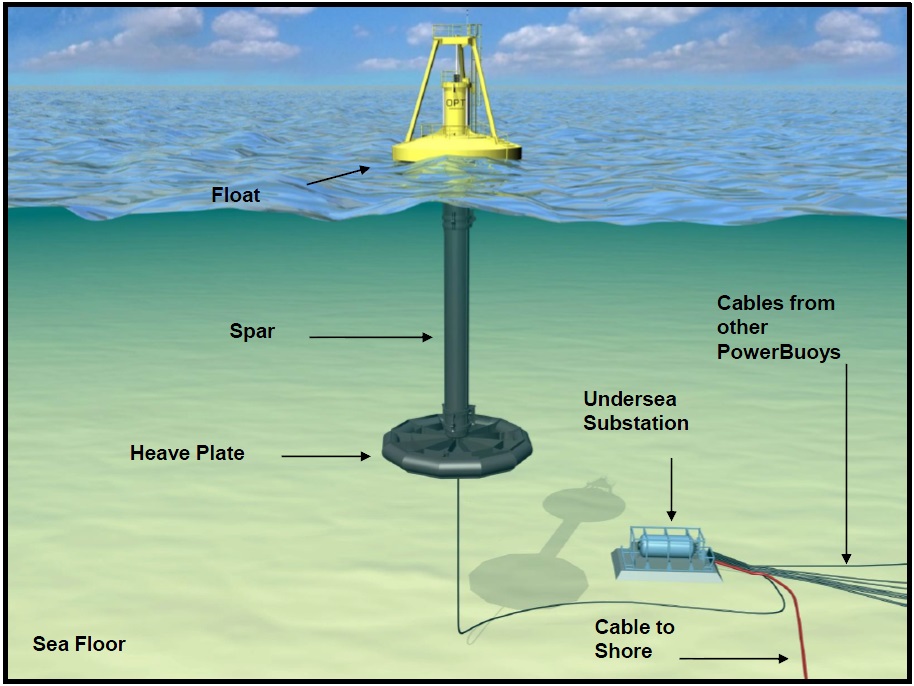
Small hydropower projects offer power solutions for many remote communities throughout the world, such as those in Nepal, India, China, and Peru, as well as for highly industrialized countries like the United States. Small hydropower systems are those that have a capacity between 0.01 to 30 megawatt (MW) of power. For reference, a 1-MW generator operating for an hour (producing 1 MWh) generates enough electricity to powers the average home in the U.S. for a little over a month. Small hydropower systems that generate less than 0.1 MW are more specifically called microhydropower systems (figure \(\PageIndex{d}\)). Most of the systems used by home and small business owners would qualify as microhydropower systems. In fact, a 10 kW system generally can provide enough power for a large home, a small resort, or a hobby farm.
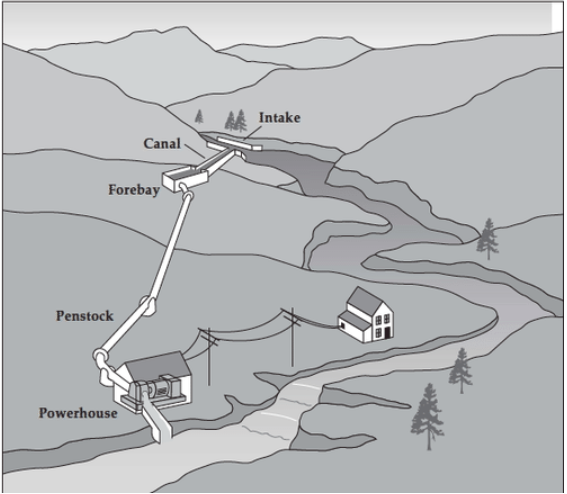
One benefit of using hydropower is that dams and reservoirs can additionally be used for recreation, flood control, and storing freshwater (see Water Scarcity and Solutions). While we will never run out of moving water, the potential to use hydropower fluctuates based on precipitation. For example, during a drought, water levels in a reservoir decreases, and there is less water released to generate electricity. As with most sources of renewable energy, hydropower is not practical everywhere, and it is most effective in mountainous regions with high rainfall and snowmelt.
Hydropower dams and the reservoirs they create degrades habitat and negatively impacts native species. For example, migration of fish to their upstream spawning areas can be obstructed by dams. In areas where salmon must travel upstream to spawn, such as along the Columbia River in Washington and Oregon, the dams block their way (figure \(\PageIndex{e}\)). This problem can be partially alleviated by using “fish ladders” that help salmon get around the dams (figure \(\PageIndex{f}\)). Fish traveling downstream, however, can get killed or injured as water moves through turbines in the dam. Reservoirs and operation of dams can also affect aquatic habitats due to changes in water temperatures, water depth, chemistry, flow characteristics, and sediment loads, all of which can lead to significant changes in the ecology and physical characteristics of the river both upstream and downstream. When reservoirs first fill with water, they inundate terrestrial (land) habitats, farms, cities, and archeological and cultural sites, sometimes forcing populations to relocate. The terrestrial vegetation slowly decomposes in oxygen-poor conditions, releasing methane into the atmosphere, a potent greenhouse gas. In this sense, hydropower generates few air pollutants during operation, but construction does contribute to climate change.

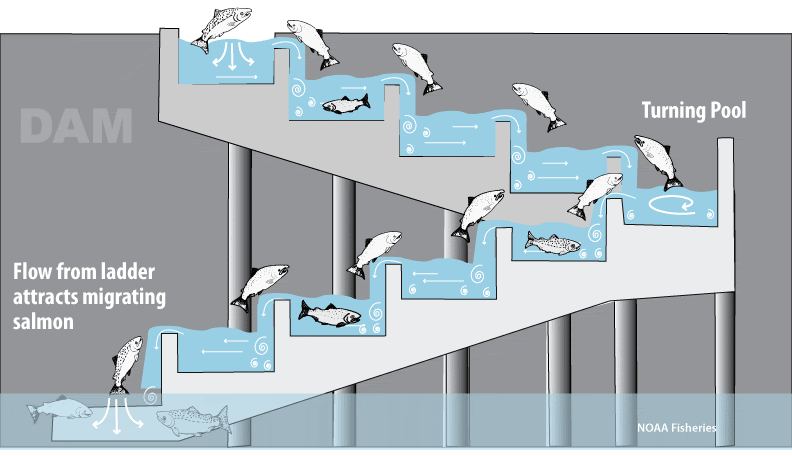
While large-scale dam hydropower projects are often criticized for their impacts on wildlife habitat, fish migration, and water flow and quality, small run-of- the-river projects are free from many of these environmental problems. Because they use the natural flow of the river, they hardly alter the stream channel and flow. Thus, effects such as oxygen depletion, increased temperature, decreased flow, and impeded upstream migration are not problems for many run-of-the-river projects.
Attribution
Modified by Melissa Ha from Renewable Energy and Challenges and Impacts of Energy Use from Environmental Biology by Matthew R. Fisher (licensed under CC-BY)


